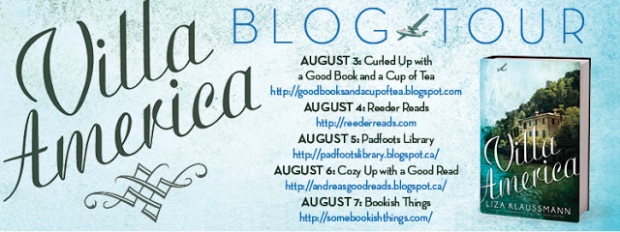I’m so excited to be a part of the Villa America Blog Tour and today’s stop is my little ‘ol blog. Yesterday, the tour began at Curled Up with A Good Book and tomorrow it’s heading to Padfoots Library. Here’s what you’ll get when you choose to pick up this amazing book:
Villa America is a fictional imagining of the real lives of Americans Sara and Gerald Murphy who, in the heady years of 1920s France, presided over a group of expatriate writers, painters, singers and dancers–including Pablo Picasso and Cole Porter, Ernest Hemingway, John Dos Passos and F. Scott Fitzgerald. This dazzling cast of characters gathered together in the Murphy home in Cap d’Antibe, as both Sara and Gerald cast their elusive magic over all of them.
Spanning 1890s New York, the battlefields of WWI, the birth of aviation, the artistic explosion of 1920s France, the Depression and the rise of fascism, Villa America charts the beautiful and tragic course of three intertwined lives to create a vivid portrait of a gilded age that couldn’t last. (source)
I got the opportunity to send a few Q’s to Liza Klaussman and she kindly sent back her A’s.
1.) How did you come up with the first, captivating, sentence, “The sky was as blue as a robin’s egg on the afternoon they pulled Owen Chamber’s body out of the Baie des Anges.”?I wanted to have the juxtaposition of the beauty of nature with the horror of death, a nod to ow the worst things can happen on the loveliest days, and how nature really doesn’t care about us at all.2.) Like F. Scott Fitzgerald in the classic, Tender is the Night, you were inspired to explore and create a fictional world involving Sara and Gerald Murphy, why?I think there is an x-factor surrounding the Murphys that attracts artists. Firstly, they had this kind of glamor, this talent for living and living well, that makes them quite special. There aren’t that many people who can pull off what they pulled off: they managed to make each of the friends feel like they were the most special, the most loved. They had a generosity and warmth that sort of beguiled all their friends. They were also artists themselves: Gerald a painter, and Sara a kind of artist of the home. Furthermore, They took a visceral delight in each other and in their children, which is something so attractive to be around.
Finally, I love any story about gangs of people: I like the ensemble piece. And here was such a gang — the Murphys, the Fitzgeralds, the Hemingways, the MacLeishs, John Dos Passos, Pablo Picasso, Cole Porter, Dorothy Parker, Bob Benchley, etc.
And finally, their story is a tragedy, a beautiful tragedy.
3.) There were so many rich and developed characters (my favourite was Gerald). Which was your favourite character to write?
I’d have to say Scott Fitzgerald was very fun to write because of his dichotomy of childish neediness and quite introvert. So even when he’s having a tantrum, underneath is this well of sadness and self-awareness. But my favorite character is probably Owen, because his silence is such antidote to the rest of these dangerously articulate people.
4.) One can only assume that you were inspired by F. Scott Fitzgerald’s work to write Villa America, but were there other historical components that help to inspire this novel?
It was through Tender Is the Night that I discovered who the Murphys were, but I was only inspired to write about them after I read Calvin Tomkins slim biography “Living Well Is the Best Revenge” and Amanda Vaill’s comprehensive biography “Everybody Was So Young”. I think of Tender Is the Night as more of a love letter to a time ins Scott Fitzgerald’s life, while Villa America is more biographical fiction, though that’s probably splitting hairs.
Either way, Tender Is the Night is one of my all-time favorite novels, but, strangely, I didn’t think much about it while was writing my book. I was reading a lot of Henry James and thinking about that world, which would have shaped the world the Murphys grew up in.
I also read quite a bit on WWI, especially letters home from the front or from pilot training and so forth. There were so many shifting sands over the Murphys lifetime — war, peace, the suffrage movement, art, music, sexuality, another war — it was really fascinating to research and to think about it.
5.) There’s a sophistication to your writing, the way you weave characters into the plot and move around history. Why did you choose to navigate your writing in this way?
Again, I’m interested in the ensemble piece, albeit with a first string and second string of characters. For me, the B characters can provide a kind of greek chorus to the main plot, but also give the reader another perspective on the events unfolding, and I think when you’re writing in the third person, that really can help give depth to the narrative.
6.) I read your book over two days in the park with a container of hummus and pita chips. What book(s) have you been reading in the park this summer?
I just finished A Little Life by Hanya Yanagihara and The Year of the Runaways by Sunjeev Sahota. Both amazing — highly, highly recommend. I also sped through Weightless by Sarah Bannan, fabulous beach read.

I love hearing about what writers have read and loved. Great interview!
This has made me even more excited to get to this book! The first line is perfection. I also love the way you read this book. Outside with appropriate snacks is always an excellent way to read.